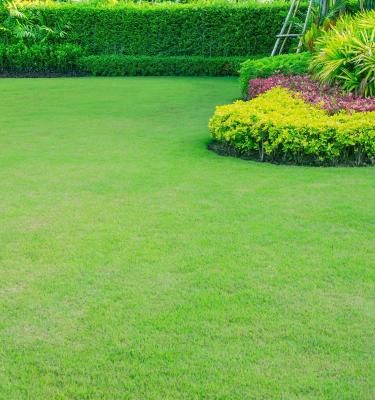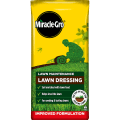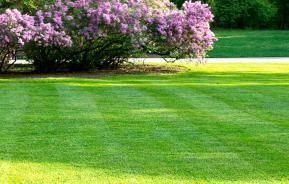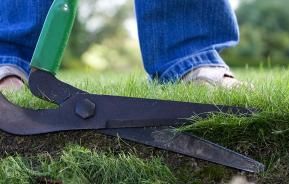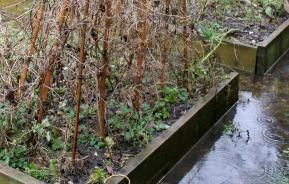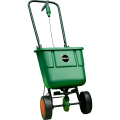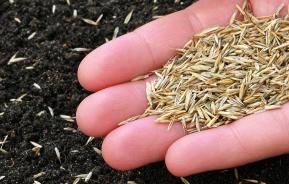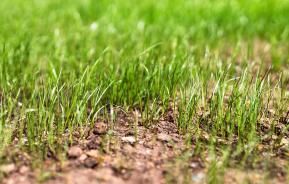Levelling a lawn by hand is a straightforward process and the results are well worth the effort!
Why is my lawn uneven?
Some of the most common causes of uneven lawns are:
Animals
From burrowing moles to foxes looking for food, animals are a main cause of uneven lawns as they will happily stray into your garden in the months your lawn is at its most vulnerable. If moles or cats are a problem in your garden, there are steps you can take to get rid of them.
Cold weather
In winter the moisture in the soil can freeze, pushing the ground upwards as it expands. Once the soil thaws, the ground may settle back into place on its own, but prolonged icy weather can leave humps which need to be dealt with.
Playing on the lawn

Lawns are a fantastic place for children to play, but running, jumping or even just walking on wet soil compacts it, causing uneven areas as well as drainage problems. This is not only bad for the health of the grass but can cause long term issues for the soil surface.
Earthworms
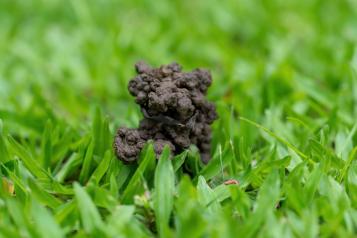
Having earthworms in your garden is a sign that your soil is in good health, but the ‘worm casts’ made up of digested soil, thatch and organic materials that they leave on the grass can make the lawn look uneven. The simplest solution is to let the casts dry, then brush them back into the turf where they will act as a soil improver.
Soil settlement
Rocks and debris beneath the soil can affect the level of your lawn, causing some areas to settle lower than others. To resolve this, excavate the affected areas and break up any rubble underneath, taking care not to damage any pipework.
Drainage problems
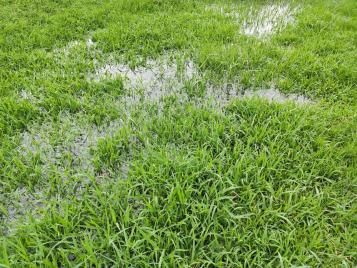
If low areas in your lawn occur around drainage pipes, it’s best to get an expert in to check the pipework and repair it if needed. Your local council should be able to provide information about drainage pipework routes on your property.
If your drainage pipes are all in good order but your lawn still has drainage issues, you may need to re-grade the lawn so that it slopes away from your property to avoid flooding, or install land drains. These are perforated pipes which are buried in the ground. Excess water in the soil soaks into the pipes through the perforations and can then be channelled away.
Once any drainage issues have been resolved, you can start to flatten your lawn.
When to level a lawn
The best time of year to level a lawn is spring, once the frosts have passed and the grass has started to grow again. This allows time for the turf to recover and newly sown grass seed to root well before summer.
Methods of levelling a lawn
There are two methods of levelling a bumpy lawn, depending on how deep the low spots are. Whichever method you use, water the lawn thoroughly a couple of days before doing any work, so that the soil is moist.
Lawn levelling tools and materials
To level a lawn, you’ll need:
- A shovel
- A garden fork
- A landscaping rake
- Lawn top dressing or lawn soil, depending on how deep the dips are
- Lawn seed
How to level shallow dips
Dips less than 2-3cm deep can be filled using lawn top dressing. This is a mixture of sand, topsoil and organic material. Top dressing helps improve drainage and also adds nutrients to the soil.
- To fill a shallow dip in a lawn, spread the top dressing across the dip, using a garden rake to spread it out and create a level surface.
- Compact the top dressing gently with your boot, or use the flat side of the rake head to tamp it down.
- Water and leave for a few days to settle.
- Once the soil has settled, spread grass seed over the area, using a lawn spreader. To ensure even coverage, scatter the seed in two directions at right angles to each other. Cover the seeds lightly with a thin layer of top dressing and tamp down gently with a boot or the palm of your hand to make sure the seed is in good contact with the soil.
- Water the area using a fine spray so as not to dislodge the seeds. If there’s no rain, you will need to water daily until the grass has germinated, then every 2-3 days or as necessary to keep the soil moist.
How to level bumps and dips deeper than 2-3cm
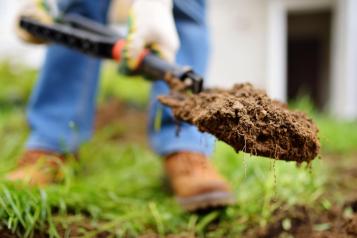
To fill dips deeper than 2-3cm, use lawn soil rather than top dressing. Our lawn soil has been treated to be weed and disease free, and is rich in nutrients that promote healthy root growth.
- Using a shovel blade, cut a cross shape 4-5cm deep into the turf over the dip, extending the arms of the cross past the edges of the dip.
- Carefully slide the blade of the shovel under the turf and peel back each section, exposing the area to be filled. Lay the peeled back sections flat on the ground – provided the soil is moist you should be able to do this without them crumbling.
- Using a garden fork, dig the exposed soil to around 5cm deep, removing large stones and breaking up any clumps of earth. Tread the soil down to make sure it won’t sink any further, then fill up the dip with topsoil until it is level with the surrounding ground. Tread on the new level surface to firm it, then fold the flaps of turf back over the area.
- To remove bumps in the lawn, cut and peel back the turf, similar to the process for filling dips, then dig out the raised area until the soil is level with the surrounding ground. Rake the soil smooth and tread it down, then fold the lifted flaps of lawn back down over the area.
- Once the flaps of turf have been folded back, tamp the turf down with your foot, starting at the outer edges of the area and working your way into the centre. Fill any gaps between the replaced sections of turf with top dressing and sprinkle lawn seed in these gaps.
- Water the lawn regularly to help the grass recover and to encourage any new lawn seed to germinate.
How to raise the level of a lawn
As well as filling deep dips, lawn soil can also be used to raise the level of a lawn. Cover the area to be raised with lawn soil until it reaches the required level, tread it lightly to compress it, water it and leave it to settle. After a few days, sow new lawn seed over the area and water regularly until the seed has germinated and is well established.
How to level a sloping lawn
Dips and bumps on a sloping lawn can be levelled in the same way as on a flat lawn. To stop the top dressing from being washed away in heavy rain, apply it thinly, so that you can still see the tips of the grass blades through the top dressing. You may need to repeat this process a few times, but with patience you’ll be able to boast a beautiful level lawn!
Check out our video tutorials for how to achieve a great looking lawn on our YouTube channel.
